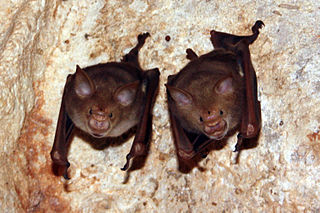
The European free-tailed bat is a species of free-tailed bat found in the Old World. Other common names include the bulldog bat and the mastiff bat because of the presence of wrinkling on the snout. This bat is found in the Mediterranean region of Europe and in scattered locations across Asia at altitudes from sea level to 3100 m. The range of distribution is from the Canary Islands and Madeira through the whole Mediterranean area, Asia Minor, the Caucasus and the Middle East. In the north to southern France, southern Germany, Switzerland, Croatia and Bulgaria. It was reported from Korea in 1931, but has not been sighted on the Korean Peninsula since then. Populations in Japan, Taiwan and Korea are now considered to be a separate species Tadarida insignis.

The rufous trident bat, Persian trident bat, or triple nose-leaf bat is a species of bat in the genus Triaenops. It occurs in southwestern Pakistan, southern Iran, the United Arab Emirates, Oman, and Yemen. In the last country, it occurs together with the much smaller Triaenops parvus. Populations from Madagascar and mainland Africa have also been assigned to T. persicus, but are referable to the species Triaenops menamena and Triaenops afer, respectively. Madagascar populations have also been referred to as Triaenops rufus, but this name is a synonym of T. persicus.
Botta's serotine is a species of vesper bat, one of 25 in the genus Eptesicus. It is found in rocky areas and temperate desert.
Christie's long-eared bat, also known as the Egyptian long-eared bat, Christie's big-eared bat, or gray long-eared bat, is a species of vesper bat in the family Vespertilionidae. It is known from North Africa and the Middle East. Its natural habitats are subtropical or tropical dry shrubland, rocky areas, and hot deserts.

The naked-rumped tomb bat is a species of sac-winged bat in the family Emballonuridae. Found in northern Africa, the Middle East, and southeastern Asia, its natural habitats are dry savanna, subtropical or tropical dry shrubland and forests, caves, and arid areas.

Patrizi's trident leaf-nosed bat is a species of bat in the family Hipposideridae. It is found in Eritrea, Ethiopia, and Saudi Arabia. Its natural habitats are subtropical or tropical dry shrubland and caves.

Asellia is a genus of bat in the family Hipposideridae. It contains the following species:

The trident bat or trident leaf-nosed bat is a species of bat in the family Hipposideridae. It is widely distributed in the Middle East, South and Central Asia, and North, East, and Central Africa. Its natural habitats are subtropical or tropical dry forests, dry savanna, subtropical or tropical dry shrubland, caves and hot deserts.

The Hipposideridae are a family of bats commonly known as the Old World leaf-nosed bats. While it has often been seen as a subfamily, Hipposiderinae, of the family Rhinolophidae, it is now more generally classified as its own family. Nevertheless, it is most closely related to Rhinolophidae within the suborder Yinpterochiroptera.

Triaenops menamena is a bat in the genus Triaenops found on Madagascar, mainly in the drier regions. It was known as Triaenops rufus until 2009, when it was discovered that that name had been incorrectly applied to the species. Triaenops rufus is a synonym of Triaenops persicus, a Middle Eastern species closely related to T. menamena— the Malagasy species had previously been placed as a subspecies of T. persicus by some authors. Triaenops menamena is mostly found in forests, but also occurs in other habitats. It often roosts in large colonies and eats insects such as butterflies and moths. Because of its wide range, common occurrence, and tolerance of habitat degradation, it is not considered to be threatened.
The Yemeni mouse-tailed bat is an endangered species of bat found in Yemen. It is only known from one roost, and its population is estimated at 150 individuals.

The African trident bat is a species of bat found in Africa.
The Yemeni trident leaf-nosed bat is a species of bat found in the Middle East.
The Egyptian mouse-tailed bat is a species of mouse-tailed bat found in North Africa and the Middle East.
The Somalian trident bat is a species of bat found in the Horn of Africa.
The Dhofar pipistrelle is a species of vesper bat in the genus Pipistrellus. It is found in Southern Arabia, including Oman and Yemen.









